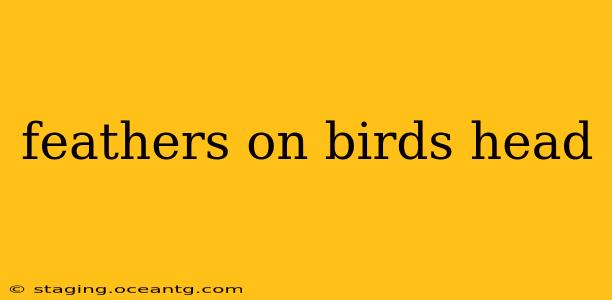Feathers adorning a bird's head are more than just aesthetically pleasing; they play crucial roles in survival, communication, and even species identification. This article delves into the diverse functions, types, and significance of these head feathers, exploring why they are so vital to avian life.
What is the purpose of feathers on a bird's head?
The purpose of feathers on a bird's head is multifaceted, varying depending on the species and the specific feather type. Generally, head feathers serve several key functions:
- Thermoregulation: Feathers provide insulation, protecting the bird's head from extreme temperatures, whether scorching sun or freezing winds. This is especially critical for birds inhabiting harsh climates.
- Protection: Head feathers offer a degree of protection from physical impacts, such as branches or predators' claws. The dense plumage can also offer some waterproofing.
- Camouflage: The color and pattern of head feathers can be crucial for camouflage, allowing birds to blend seamlessly into their environment, evading predators and ambushing prey.
- Display and Communication: Many bird species utilize head feathers in elaborate displays for courtship, territorial defense, or warning signals. Bright colors, crests, and other specialized head feathers are often prominent features in these displays.
- Sensory Function: Some head feathers, especially around the eyes and beak, may have a sensory function, assisting the bird in navigating its environment or detecting prey. These feathers are often highly sensitive.
What are the different types of feathers on a bird's head?
While all feathers share a basic structure, head feathers can display remarkable diversity in shape, size, and texture:
- Plumes: These soft, fluffy feathers often form a crest or ruff on the bird's head, contributing to insulation and display.
- Filoplume: These thin, hair-like feathers are often found interspersed among other feathers and may have a sensory role.
- Contour Feathers: These provide the bird's overall shape and streamline its body. Head contour feathers can be particularly striking in color and pattern.
- Bristles: Short, stiff feathers found around the eyes and beak, these often have a sensory function, protecting the eyes from debris and assisting in prey detection.
What are the head feathers called?
There isn't one specific name for all head feathers. The terminology depends on the specific type and location of the feather. For example, a prominent crest on a bird's head might be described as a "crest," while the shorter, protective feathers around the eyes are called "bristles." Detailed descriptions often utilize anatomical terminology specific to avian morphology.
How do birds keep their head feathers clean?
Birds employ various methods to maintain the cleanliness of their head feathers:
- Preening: This regular grooming behavior involves using the beak to smooth, arrange, and clean feathers. Preening also distributes oils produced by the preen gland, which helps waterproof and condition the feathers.
- Dust Bathing: Rolling in dust helps remove parasites and debris from the feathers.
- Water Bathing: Washing in water can further cleanse the feathers and remove dirt.
Do all birds have feathers on their heads?
While the vast majority of birds have feathers on their heads, there are variations. Some species have sparsely feathered heads, while others have bald patches or highly specialized head feather arrangements. The degree and type of head feathering are species-specific and reflect adaptations to their particular environment and lifestyle.
Why are head feathers important for bird identification?
Head feathers play a significant role in bird identification. The color, pattern, shape, and arrangement of head feathers are often distinctive characteristics that help differentiate between species, subspecies, and even sexes within a species. Bird guides and field guides extensively utilize head feather characteristics to aid in bird identification.
By understanding the diverse functions, types, and significance of feathers on a bird's head, we gain a deeper appreciation for the complexity and beauty of avian evolution and adaptation. The seemingly simple head feathers are, in fact, vital components of a bird’s survival and communication strategies.
